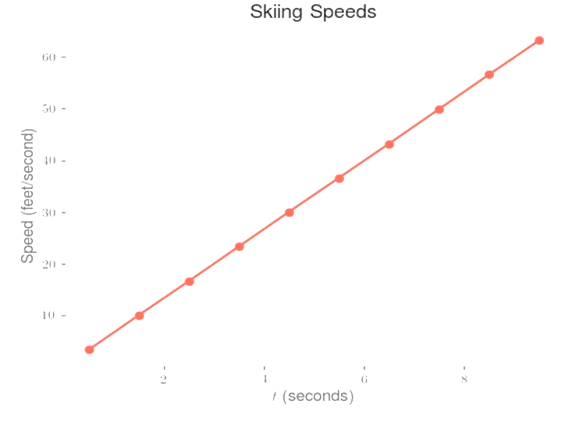
(a)
The representation for derivative of a function.
(a)
Answer to Problem 29E
The derivative represent the speed .
Explanation of Solution
Given information:
The given table skiing distances
| Time | Distance Traveled (feet) |
| 0 | 0 |
| 1 | 3.3 |
| 2 | 13.3 |
| 3 | 29.9 |
| 4 | 53.2 |
| 5 | 83.2 |
| 6 | 119.8 |
| 7 | 163.0 |
| 8 | 212.9 |
| 9 | 269.5 |
| 10 | 332.7 |
Formula Used:
Speed formula of an object:
Calculation:
The derivative represent the distance covered per unit of time.
Since,
Hence, the derivatives represent speed.
(b)
The units of the derivatives to be measured.
(b)
Answer to Problem 29E
The unit is in feet per second.
Explanation of Solution
Given information:
The given table skiing distances
| Time | Distance Traveled (feet) |
| 0 | 0 |
| 1 | 3.3 |
| 2 | 13.3 |
| 3 | 29.9 |
| 4 | 53.2 |
| 5 | 83.2 |
| 6 | 119.8 |
| 7 | 163.0 |
| 8 | 212.9 |
| 9 | 269.5 |
| 10 | 332.7 |
Formula Used:
Speed formula of an object:
In the table the distance are given in feet and the time are given in second.
Since,
Hence, the unit is in feet per second.
(c)
To calculate:The equation of the derivative.
(c)
Answer to Problem 29E
The expression of the straight line is
Explanation of Solution
Given information:
The given table skiing distances
| Time | Distance Traveled (feet) |
| 0 | 0 |
| 1 | 3.3 |
| 2 | 13.3 |
| 3 | 29.9 |
| 4 | 53.2 |
| 5 | 83.2 |
| 6 | 119.8 |
| 7 | 163.0 |
| 8 | 212.9 |
| 9 | 269.5 |
| 10 | 332.7 |
Formula Used:
Slop of a straight line:
Point slop form of a straight line:
Here
Draw the graph of the derivatives. Use the data’s of the given table

The derivatives represents a linear function. Thus it must contain a slop.
Consider any two points on the line.
Let two points be
Now, calculate the slop. Use the slop formula
Now, find the equation of the linear equation. Use the point slop formula
Hence, the expression of the straight line is
Chapter 3 Solutions
Calculus: Graphical, Numerical, Algebraic
Additional Math Textbook Solutions
Introductory Statistics
Elementary Statistics: Picturing the World (7th Edition)
A First Course in Probability (10th Edition)
Pre-Algebra Student Edition
University Calculus: Early Transcendentals (4th Edition)
- Prove 11.1.2arrow_forward39. (a) Show that Σeak converges for each α > 0. (b) Show that keak converges for each a > 0. k=0 (c) Show that, more generally, Σk"eak converges for each k=0 nonnegative integer n and each a > 0.arrow_forward#3 Find the derivative y' = of the following functions, using the derivative rules: dx a) y-Cos 6x b) y=x-Sin4x c) y=x-Cos3x d) y=x-R CD-X:-:TCH :D:D:D - Sin f) Sin(x²) (9) Tan (x³)arrow_forward
 Calculus: Early TranscendentalsCalculusISBN:9781285741550Author:James StewartPublisher:Cengage Learning
Calculus: Early TranscendentalsCalculusISBN:9781285741550Author:James StewartPublisher:Cengage Learning Thomas' Calculus (14th Edition)CalculusISBN:9780134438986Author:Joel R. Hass, Christopher E. Heil, Maurice D. WeirPublisher:PEARSON
Thomas' Calculus (14th Edition)CalculusISBN:9780134438986Author:Joel R. Hass, Christopher E. Heil, Maurice D. WeirPublisher:PEARSON Calculus: Early Transcendentals (3rd Edition)CalculusISBN:9780134763644Author:William L. Briggs, Lyle Cochran, Bernard Gillett, Eric SchulzPublisher:PEARSON
Calculus: Early Transcendentals (3rd Edition)CalculusISBN:9780134763644Author:William L. Briggs, Lyle Cochran, Bernard Gillett, Eric SchulzPublisher:PEARSON Calculus: Early TranscendentalsCalculusISBN:9781319050740Author:Jon Rogawski, Colin Adams, Robert FranzosaPublisher:W. H. Freeman
Calculus: Early TranscendentalsCalculusISBN:9781319050740Author:Jon Rogawski, Colin Adams, Robert FranzosaPublisher:W. H. Freeman
 Calculus: Early Transcendental FunctionsCalculusISBN:9781337552516Author:Ron Larson, Bruce H. EdwardsPublisher:Cengage Learning
Calculus: Early Transcendental FunctionsCalculusISBN:9781337552516Author:Ron Larson, Bruce H. EdwardsPublisher:Cengage Learning





